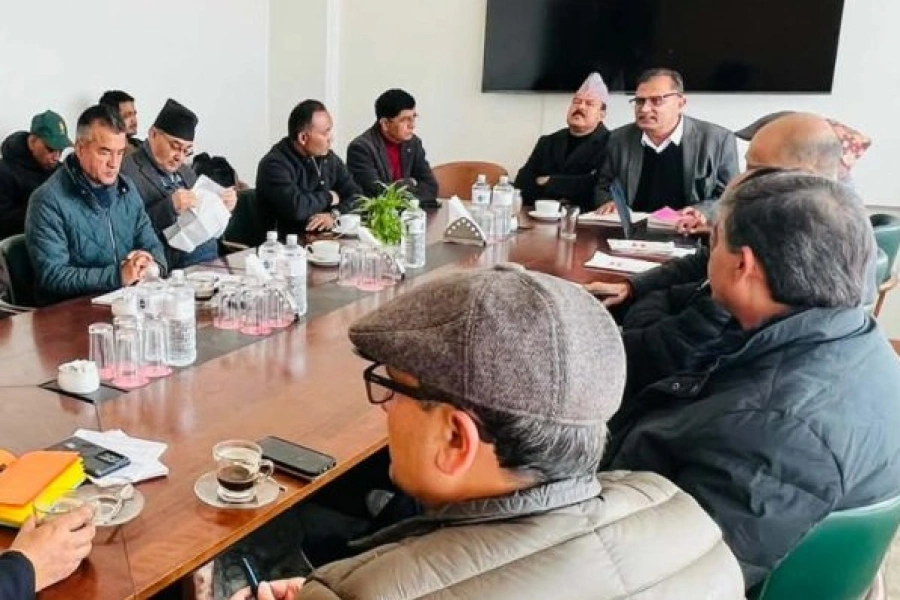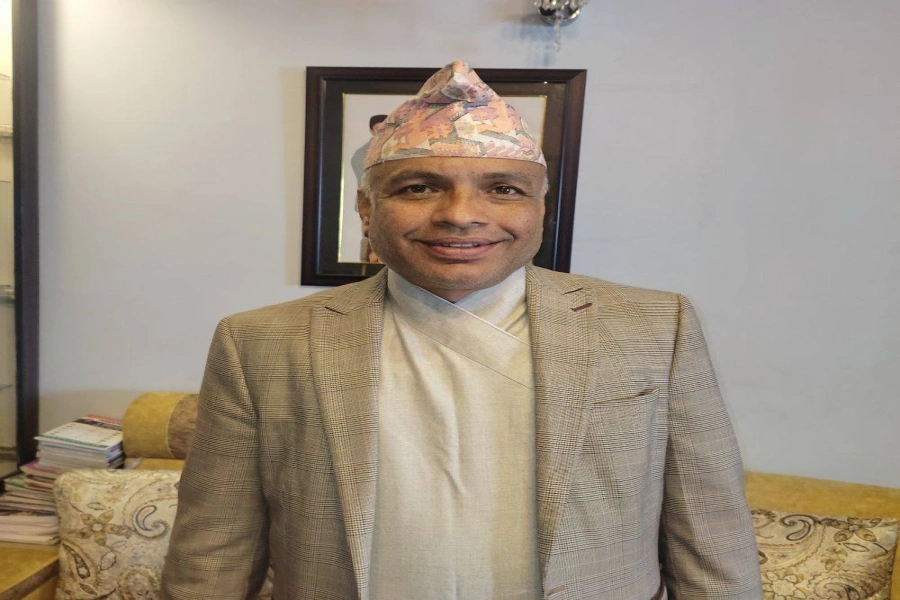“What will you write about Nepali films? In fact, what is there to write about, that too in an English national daily? Do you think people who read English daily would ever care to read about Nepali films?”[break]
I still remember these quick feedbacks I received then. In fact, many of them who said so were not wrong. English newspaper in the capital hardly ever bothered to know that something called Nepali film industry existed.
Honestly speaking, when I started to write about Nepali films, I did so without any high expectation. I was not even sure that I could actually continue to write about Nepali films for so many years.
In Nepal, writing about Nepali films in English media was definitely a job that would often go overlooked. There were two main reasons for this. One, people who read English dailies rarely went for Nepali movies. Two, for those who were fond of Nepali films, there already existed various Nepali tabloids to feed them with all that they wanted to know. So, basically, I started with the feeling that perhaps I was writing for nobody. When I chose to write about Nepali films, I already had this in my mind that my articles would mostly go unread. All that I ever wanted to do was make a beginning at the least. Therefore, even a single person reading out the headline of my story made me happy.

It was certainly not that easy to write about Nepali cinema because there were no materials, no archive and literally nothing to refer to. I still remember when for the first time (five years ago) I browsed Google and Wikipedia for resource materials on Nepali films. All that the search engines retrieved was the profile of Rajesh Hamal and Bhuwan KC and tidbits on Karishma Manandhar and Manisha Koirala. In fact, if you type Kollywood (as the Nepali film industry is popularly known in Nepal) in Google, it shows links to South Indian film sites because South Indian film industry too goes by the name of Kollywood. Thanks to the growing online access and websites, now there is much more you can find on Nepali films on the web.
Sadly, even Film Development Board (FDB) of Nepal has nothing that can be useful to anybody who wants to have a better understanding of Nepali films.
History and phases
While Aama, released in October 7, 1964, is still believed to be the first Nepali motion picture, it is still a subject of debate whether the film indeed can be officially declared the first Nepali film. Though produced by India and released in Calcutta (now Kolkata), DB Pariyar’s Satya Harishchandra was the first film to be shot in Nepali language. It was released in September 14, 1951.
Royal Nepal Film Corporation (RNFC) took charge of producing Nepali films and introduced actors like Bhuwan Chand (Thapa), Shiva Shanker, Bishwa Basnet, Uttam Nepali, CP Lohani, Basundhara Bhusal and Gautam Ratna Tuladhar, who are the pioneer actors of Nepal. All those films that were made during the golden era of Nepali film industry (1951-1980) are still regarded as the finest films of Nepal because these films were made by professional filmmakers such as Hira Singh Khatri, BS Thapa, Prakash Thapa, Pratab Subba, Laxminath Sharma, Pradip Rimal, Sambhu Pradhan, Tulsi Ghimire and Ugen Chopel.
While films produced between 1951-1980 such as Satya Harischandra, Aama, Maitighar, Hijo Aja Bholi, Parivartan, Kumari, Sindoor and Jeevan Rekha became the pioneer films of Nepali film fraternity, the era between 1981-1990 gave a different dimension to Nepali film scene with hits like Baansuri, Badlido Aakash, Kaanchhi, K Ghar K Dera, Basudev, Samjhana, Kusume Rumal, Lahure, Saino, Bhagya Rekha and Santaan.
My perspective on Nepali film industry is that it was doing fine until 1995 when films like Chino, Koseli, Dui thopa Aansu, Kanyandan and Behuli had made a very good impression on the Nepali movie goers.
Actors like Bhuwan KC, Shiva Shrestha, Saroj Khanal, Kristi Mainali, Hari Bansha Acharya, Madan Krishna Shrestha, Sunny Rauniar, Tripti Nadekar and Gauri Malla were polished and for Nepal they became the promising second generation actors.

WHAT WENT WRONG IN-BETWEEN?
Hamal’s overlooking
I might be right or wrong for saying this, but Nepali film industry started going downhill from the post-1995 era. While the second generation actors started to slowdown and prominent filmmakers like Hira Singh Khatri, BS Thapa and Prakash Thapa were no more in the Nepali film scene, new directors, producers and actors came into the field to try their hands.
Actor Rajesh Hamal’s debut in Yug Dekhi Yug Samma in 1991 heralded a new direction in Nepali silver screen. Rajesh Hamal became a star overnight and he literally went on to overshadow the craze Nepali moviegoers had for any other actor in the scene so far. From 1991 to 1995 Rajesh Hamal became the only actor to have done 13 lead roles in 13 films (Yug Dekhi Yug Samma, Adhikar, Bhauju, Deuki, Deuta, Chatyang, Kasam etc).
Hamal did the best as an actor initially. But soon he was carried away by his stardom to such an extent that he began to accept any roles offered to him. I strongly believe that if only Rajesh Hamal had turned sensible in selecting films, if only he had demanded a change in Nepali silver screen, Nepali film industry would have reached a different height of success today.
At a time when there were very few people in the industry, who were educated and had sound knowledge of films, Rajesh Hamal was one of those very rare personalities whose image, both on- and off-screen, carried certain weight. If only he had preferred to do films made by well-meaning people, producers would have definitely nodded to his commands.
Instead he just went on with the rat-race for completing a film within 3 months before moving on to the next. If we look back at Hamal’s film career from Yug Dekhi Yug Samma (1991) to The Yug Dekhi Yug Samma (2009) and Dharma (2010), it is obvious that he has remained a stereotype.
The bureaucracy
Nepali silver screen that was in its mediocre phase by 1996, slid into a crisis period after 2000. The last decade has been both curse and blessing to the industry. After 1999, new directors and producers of Nepali films focused rather on bureaucracy than filmmaking.
The establishment of Film Development Board (FDB) on June 30, 2000, under the chairmanship of Yadhav Kharel, served nothing but the government propaganda to keep a bureaucratic hold over the motion pictures. Frankly speaking, FDB has till date functioned merely as a puppet of the government of Nepal.
Simultaneously, directors and producers such as Narayan Puri, Ashok Sharma and Yubaraj Lama were rather busy locking horns on petty issues than producing anything substantial. Different associations like Nepal Film Producer’s Association, Nepal Film Director’s Association, Nepal Indigenous Film Association and Nepal Film Technician Association were established. Rather than creating platforms to improve films, the associations were turned into a body for muscle flexing or staging protests over slight disagreements. The point is they were not making movies. I am reminded of what late King Mahendra once told – “Artistes and art should stay far away from politics as they are pure and divine.”

Market
Every time I met someone related to the industry, I was told that “Nepali film has no market.” I do not wholly agree with this statement because it is contradictory. I have heard from the directors, actors and producers while I interact with them during interviews that their films are running houseful throughout the country.
The recent example would be Rekha Films’ Kasle Choryo Mero Mann. Actor Rekha Thapa in an interview was quoted saying “My film has made more than ten million rupees in less than a week of its release.” If a film worth seven million rupees earns more than 10 million in less than a week, wouldn’t it be stupid to say Nepali films don’t have market!
The fact that cannot be denied is that eighty percent of Nepali film-goers are people living outside the capital. And most of these viewers are still in the awe of either Rajesh Hamal or Nikhil Uprety and that is why Nepali mainstream filmmakers have very limited choice as they don’t want to take a risk experimenting with filmmaking to attract a wider set of audience.
Change
With Quest Entertainment producing films and Bhusan Dahal directing, Kagbeni (2008), set a stage for digital revolution in Nepali filmmaking scenario. At a time when all filmmakers were fond of stretching 16 mm length cinema into 35 mm projector, Kagbeni shot in 2K camera proved that cinematography is one of the most important elements in any film.
The new crop of filmmakers joined the digital bandwagon and started focusing on the presentation of the films. Director Alok Nembang charmed viewers with his presentation of Sano Sansar in 2008. Likewise, other films like Mero Euta Saathi Chha, Kusume Rumal (sequel), Mission Paisa and Basma Chaina Mero Yo Mann gave a different look to Nepali films in terms of cinematography, choreography, star cast, marketing and packaging.
In a different line
While mainstream Nepali movies are struggling among themselves to establish their niche, documentaries and short-films have been more successful in their own little geography.
Filmmakers and writers like Nabin Subba, Bhusan Dahal, Basanta Thapa, Deepak Rauniyar, Manoj Pandit, Prachanda Man Shrestha, Dil Bhusan Pathak, and Prawin Adhikary have been doing better jobs than many self-proclaimed mainstream filmmakers of Nepal. Deepak Rauniyar’s Threshold, which was screened at the Cannes, is a case in point.
In 2010
Three films that became the biggest talk of the tinsel town were Simos Sunuwar’s First Love, Alok Nembang’s Kohi Mero and Manoj Pandit’s Dasdhunga. Undoubtedly, Dasdhunga was the “year-stealer” film for 2010. Close to reality, experimental and proper execution is what made Dasdhunga a marvelous project.
Looking ahead in 2011
2011 now awaits films such as Batch No 16, Goodbye Kathmandu, My Love Story, Kathmandu, Miss U, Mrigatrishna, Purple Days and Swor. You can easily ignore about more than one dozen other mainstream movies as they are surely going to be the typecast projects like they have been since 1996.
Actors such as Aryan Sigdel, Karma, Vinay Shrestha, Namrata Shrestha, Richa Sharma, Richa Ghimire, Saugat Malla, Varun SJB Rana, Jharana Bajracharya, Ruby Bhattarai and Nisha Adhikary are the stars to look up for rather than falling blindly in love once again with Rajesh Hamal, Rekha Thapa, Nikhil Uprety and Biraj Bhatta. And that’s that.
Avash Karmacharya is the Program Officer of Indian Culture Center (ICC), Indian Embassy. Views expressed here are of the author’s and not of ICC.
Akshay Kumar reacts to boycott 'Raksha Bandhan', 'Laal Singh Ch...




































